A temperature transmitters converts
the thermocouple or
RTD signal to a
4-20 mA output signal and is the ideal solution for many remote
temperature measurement applications. 4-20ma transmitters have definite advantages over conventional
temperature measuring devices, but must be selected with caution in order to avoid “ground loop” problems.
Why use temperature transmitters?
In many cases, the temperature of a remote process must be monitored. Common temperature sensing devices such as thermocouples and RTD’s produce very small “signals.” These sensors can be connected to a two-wire transmitter that will amplify and condition the small signal. Once conditioned to a usable level, this signal can be transmitted through ordinary copper wire and used to drive other equipment such as
meters,
dataloggers,
chart recorders, computers or
controllers.
How to use a temperature transmitter?
A temperature transmitter draws current from a remote dc power supply in proportion to its sensor input. The actual signal is transmitted as a change in the power supply current.
Specifically, a thermocouple input transmitter will draw 4 mA of current from a dc power supply when measuring the lowest temperature of the process. Then, as the temperature rises, the thermocouple transmitter will draw proportionally more current, until it reaches 20 mA. This 20 mA signal corresponds to the thermocouple’s highest sensed temperature. The transmitter’s internal signal-conditioning circuitry (powered by a portion of the 4-20 mA current) determines the temperature range that the output current signal will represent.
Physically, only two copper wires are necessary to connect the temperature transmitter output signal in a series circuit with the remote power supply and the process equipment. This is made possible since the signal and the power supply line are combined (one circuit serves a dual function).
Choose the right temperature transmitter
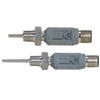 Compact M12 RTD Transmitters
Compact M12 RTD Transmitters
This unique probe is ideal for areas with space limitations where traditional head connections are too large to fit. The M12 thread design offers a secure industrial connection.
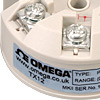 Smart Temperature Transmitters
Smart Temperature Transmitters
This smart head transmitter that accepts thermocouple temperature sensors and converts sensor output over a configured range to a standard industrial (4 to 20 mA) transmission signal.
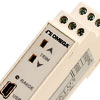 DIN Rail Temperature Transmitter
DIN Rail Temperature Transmitter
The TXDIN1600 Series is a new generation DIN rail mounted temperature transmitter. It has been designed to accept most common process and temperature sensor inputs and provide the user with a standard two wire 4 to 20 mA output signal. Isolation is provided between input and output and all temperature ranges are linear to temperature.
Frequently Asked Questions
Advantages of temperature transmitters
Transmitters offer numerous advantages over the more traditional ways of measuring temperature.
- ac power is not needed at the remote location to operate a twowire transmitter.
Since transmitters are powered by a low level 4-20 mA output current signal, no additional power has to be supplied at the remote location. In addition, the usual 24 Vdc signal necessary for operation is standard in plants that have large amounts of instrumentation.
- Electrical noise and signal degradation are not a problem for two-wire transmitter users.
The transmitter's current output signal lends itself to a high immunity when it comes to ambient electrical noise. Any noise that does appear in the output current is usually eliminated by the common-mode rejection of the receiving device. In addition, the current output signal will not change (diminish) with distance as most voltage signals do.
- Wire costs drop significantly when using transmitters.
Low voltage signals produced by thermocouples almost always require the use of shielded cable when they are sent any significant distance. Ambient electrical noise from arcing electrical relays, motors and ac power lines can raise havoc with these signals that are transmitted in an unshielded cable. In addition, expensive, heavy gage wire is often installed in applications that call for long cable runs (since it reduces errors from signal voltage drops caused by line resistance).
Ordinary copper wire can be used to connect all the pertinent equipment in a two-wire transmitter system. The 4-20 mA current output signal is relatively immune to ambient electrical noise and is not degraded by long distance transmission, even over a small diameter wire. Adding a temperature transmitter to a system eliminates the problem of having to provide long runs of costly wire and an extensive amount of shielding.
Ground loop problems
If a grounding rod was driven into the earth at two different points and a voltmeter was connected between them, a voltage difference would be detected between the two. This difference in potential exists between practically any two points along the earth’s surface. When one tries to measure a process that is at a remote location, this voltage difference will induce an error current along the line, which is referred to as a “ground loop” signal. Its result will be an error at the display.
To prevent “ground loop” errors of this type, select an isolating temperature transmitter for your system. This type of transmitter will optoelectronically isolate the sensor signal from the output current loop. This will allow the user to ground both the sensor and one side of the current loop.
Features of the temperature transmitter
Transmitters provide a two-wire output with the same wiring used for power and output. The load resistance is connected in series with a dc power supply, and the current drawn from the supply is a 4-20 mA or output signal which is proportional to the input signal.
Two-wire transmission permits remote mounting of the transmitter near the sensor to minimize the effects of noise and signal degradation to which low level sensor outputs are susceptible.
A rugged metal enclosure, suitable for field mounting, offers environmental protection and screw terminal input and output connections. This enclosure may be either surface or standard relay track mounted.
Most temperature transmitters are linearized to the voltage signal produced by the thermocouple or RTD, although there are new models now available that are linearized to the actual temperature.
The temperature transmitters convert the thermocouple or RTD signal to a 4-20 mA output signal. Some models will convert to an RS-232C output. Transmitters are available with dip switch selection for several thermocouple types per model, as well as thermocouple and RTD selection on a single model. RTD or thermocouple transmitters are available in either isolating or non-isolating models, and they also feature output ranging adjustments with zero and span adjustments over 80 to 100% (depending on model) of the sensor range.
 CLOSE
CLOSE




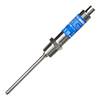
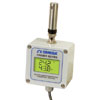
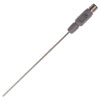
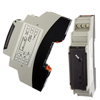
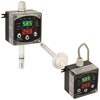
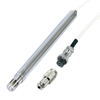

 Termopar
Termopar Thermocouples - French
Thermocouples - French Termopares
Termopares Termopares
Termopares Thermocouples
Thermocouples Termokobler
Termokobler Thermocouples
Thermocouples Thermoelementen
Thermoelementen Termocoppie
Termocoppie Thermocouples
Thermocouples Termopares
Termopares Thermocouples
Thermocouples Thermocouples
Thermocouples 热电偶
热电偶 Thermocouples
Thermocouples
 熱電対
熱電対 열전대
열전대 Thermocouples
Thermocouples
 Thermocouples
Thermocouples
 Thermocouples
Thermocouples
 Thermocouples
Thermocouples
 Thermocouples
Thermocouples